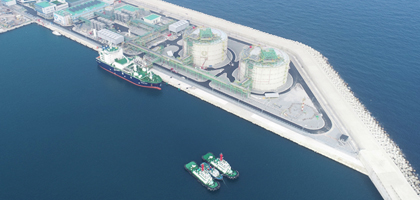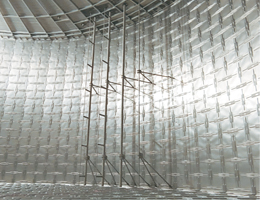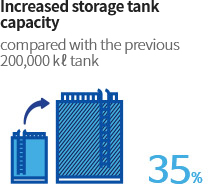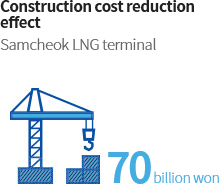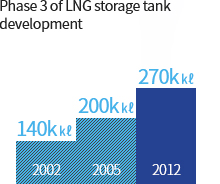KOGAS
-
World’s Largest LNG Storage Tank
KOGAS built the world’s first fully membrane-protected LNG storage tank at Jeju LNG Terminal in 2019.
The type of LNG storage tank is internationally standardized, applying the 9% nickel steel method and the membrane method, which are constructed by most countries around the world. KOGAS Research Institute has designed a 9% nickel steel tank for use at home and abroad. We designed the world’s first super-capacity tank of 270,000 kl, installed it in the Samcheok terminal, and exported it to the Singapore Terminal. As international standards were enacted in 2010 to regard membrane type tanks as full containment type, a new market for membrane tanks emerged mainly in developed countries. Accordingly, KOGAS built a fully membrane-protected LNG storage tank at the Jeju terminal in 2014, and with the record of being the first in this field, KOGAS is pursuing future overseas projects.
-
-
Development Background
With 72 LNG storage tanks, KOGAS has the world’s largest LNG storage capacityb :
(11.47 million kl). Since the construction cost of LNG storage tanks is so great that it accounts for half of the total LNG terminal construction cost, increasing tank size, thereby reducing construction costs and increasing site efficiency, is becoming a global trend. KOGAS has developed the next-generation ultra-large LNG storage tank by actively utilizing LNG storage tank localization technology and construction know-how acquired through existing research and development. -
Development Process
We began the LNG storage tank localization development project in 1997. Afrter 5 years of R&D, it succeeded in developing a 9% nickel tank and a membrane tank following France and Japan. In 2005, we succeeded in developing a 200,000 kl storage tank, and it has been installed in LNG terminal in Tongyeong and Pyeongtaek, and has been in commercial operation since 2010. In 2012, 270,000 kl LNG storage tank design technology was secured, and three units are currently in operation at the Samcheok LNG terminal.
-
Core Technology
LNG storage tanks encompass a comprehensive engineering field that incorporates various technologies such as process, machinery, civil engineering, electricity, and piping. Increasing tank size requires development of design technology in mechanical and civil engineering. KOGAS developed a super-capacity 270,000 kl LNG storage tank through comprehensive review of the thickness of the steel sheet that can be constructed in the inner tank, the rate of evaporation in the storage tank, and seismic load. In particular, the design was strengthened to accommodate earthquakes registering 7.0 on the Richter Scale (previously 6.5), and the optimal design was found allowing for both safety and economy. The safety of the super-capacity LNG storage tank was verified through international classification certification (DNV, Norway).
-
Benefit
A larger storage tank means that a large amount of LNG can be stored at once.
When the LNG storage tank at Samcheok LNG terminal was constructed, a 270,000 kl storage tank was installed, saving approximately KRW 70 billion in construction cost, compared with conventional normal-sized storage tanks.
It is expected that this will have a positive impact on overseas liquefaction plant construction orders by improving the usability of the terminal site as well as price competitiveness.
In 2014, a Korean consortium participated in the Singapore SLNG expansion project, and successfully signed a contract for a 270,000 kl LNG storage tank.

